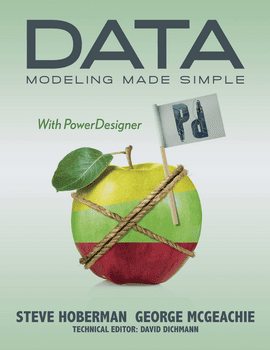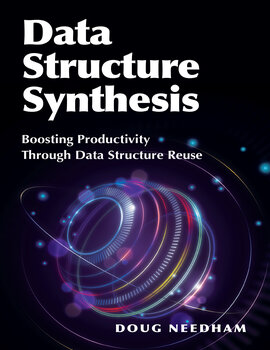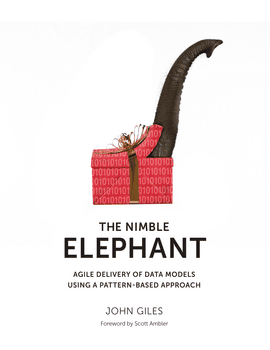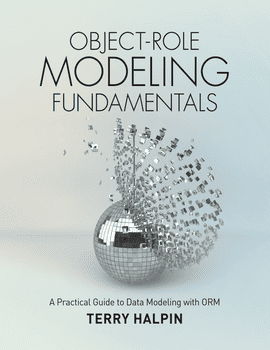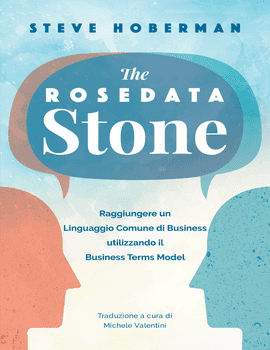Data Modeling Made Simple with PowerDesigner
Data Modeling Made Simple with PowerDesigner, by Steve Hoberman and George McGeachie
Data Modeling Made Simple with PowerDesigner will provide the business or IT professional with a practical working knowledge of data modeling concepts and best practices, and how to apply these principles with PowerDesigner.
Topics
SECTION I: Data Modeling Introduction
CHAPTER 1: What is a data model?
CHAPTER 2: Why do we need a data model?
SECTION II: Data Model Components
CHAPTER 3: What are entities?
CHAPTER 4: What are data elements?
CHAPTER 5: What are relationships?
CHAPTER 6: Why are names and definitions important?
CHAPTER 7: What are keys?
SECTION III: Data Modeling in PowerDesigner
CHAPTER 8: Why do we need a data modeling tool?
CHAPTER 9: What can PowerDesigner do for me?
CHAPTER 10: How can we work within the PowerDesigner environment?
CHAPTER 11: How do I create entities in PowerDesigner?
CHAPTER 12: How do I create data elements in PowerDesigner?
CHAPTER 13: How do I create relationships in PowerDesigner?
CHAPTER 14: How do I create keys in PowerDesigner?
SECTION IV: Subject Area, Logical, and Physical Data Models
CHAPTER 15: What are subject area models?
CHAPTER 16: What are logical data models?
CHAPTER 17: What are physical data models?
CHAPTER 18: How can we connect these models in PowerDesigner?
SECTION V: Consolidating What We’ve Learned
CHAPTER 19: How do we put all of the pieces together?
SECTION VI: More Great Stuff in PowerDesigner for Data Modelers
CHAPTER 20: What other data modeling features exist in PowerDesigner?
CHAPTER 21: How do we get information in and out of PowerDesigner?
CHAPTER 22: How can PowerDesigner help me improve data model quality?
CHAPTER 23: What other components in PowerDesigner can be leveraged by data modelers?
SECTION VII: Beyond Data Modeling in PowerDesigner
CHAPTER 24: What’s different about the XML Physical Data Model?
CHAPTER 25: What other models are available in PowerDesigner?
You’ll build many PowerDesigner data models along the way, increasing your skills first with the fundamentals and later with more advanced feature of PowerDesigner. This book combines real-world experience and best practices to help you master the following ten objectives:
This book has ten key objectives for you, the reader:
1. You will know when a data model is needed and which PowerDesigner models are the most appropriate for each situation
2. You will be able to read a data model of any size and complexity with the same confidence as reading a book
3. You will know when to apply and how to make use of all the key features of PowerDesigner
4. You will be able to build, step-by-step in PowerDesigner, a pyramid of linked data models, including a conceptual data model, a fully normalized relational data model, a physical data model, and an easily navigable dimensional model
5. You will be able to apply techniques such as indexing, transforms, and forward engineering to turn a logical data model into an efficient physical design
6. You will improve data governance and modeling consistency within your organization by leveraging features such as PowerDesigner’s reference models, Glossary, domains, and model comparison and model mapping techniques
7. You will know how to utilize dependencies and traceability links to assess the impact of change
8. You will know how to integrate your PowerDesigner models with externally-managed files, including the import and export of data using Excel and Requirements documents
9. You will know where you can take advantage of the entire PowerDesigner model set, to increase the success rate of corporate-wide initiatives such as business intelligence and enterprise resource planning (ERP)
10. You will understand the key differentiators between PowerDesigner and other data modeling tools you may have used before
This book contains seven sections:
Section I introduces data modeling, along with its purpose and variations.
Section II explains all of the components on a data model including entities, data elements, relationships, and keys. Also included is a discussion of the importance of quality names and definitions for your objects.
Section III explains the important role of data modeling tools, the key features required of any data modeling tool, and an introduction to the essential features of PowerDesigner. It also describes how to create and manage data modeling objects in PowerDesigner.
Section IV introduces the Data Model Pyramid, then dives into the relational and dimensional subject areas, logical, and physical data models, and describes how PowerDesigner supports these models and the connections between them.
Section V guides you through the creation of your own Data Model Pyramid.
Section VI focuses on additional PowerDesigner features (some of which have already been introduced) that make life easier for data modelers. Learn how to get information into and out of PowerDesigner, and improve the quality of your data models with a cross-reference of key PowerDesigner features with the Data Model Scorecard®.
Section VII discusses PowerDesigner topics beyond data modeling, including the XML physical model and the other types of model available in PowerDesigner.
About Steve and George
Steve Hoberman is a world-recognized innovator and thought-leader in the field of data modeling. He has worked as a business intelligence and data management practitioner and trainer since 1990. He is the author of Data Modelers Workbench and Data Modeling Made Simple, the founder of the Design Challenges group and the inventor of the Data Model Scorecard®.
George McGeachie has worked in the field of data modeling and metadata in a variety of industries for many years. George has evaluated, implemented, tailored and used various data modeling and metadata management tools during data modeling assignments around the globe. He is always regarded as a power user for whichever tool is in use, finding new ways of exploiting their capabilities.
Faculty may request complimentary digital desk copies
Please complete all fields.
